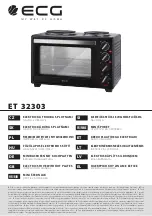
Hearthstone Quality Home Heating Products, Inc
®
Shelburne Model 8371
Wood moisture content plays a key role in the
performance of your stove. Wood freshly cut from a
living tree (green wood) contains a great deal of
moisture. As you might expect, green wood burns
poorly. You must season green wood before using it
in your woodstove. To season green wood properly,
split, stack, and allow it to air dry for a period of one
year. Green wood may provide less than 2000 Btu
per pound, whereas dry wood can provide up to
7000 Btu per pound.
Stack firewood on pallets or blocks to keep it off the
ground; cover only the top of the stack. Plastic or
tarps that cover the sides of the woodpile trap
moisture and prevent the wood from drying. As for
stacking, an old Vermonter said, "The spaces
between the logs should be large enough for a
mouse to get through, but not for the cat that's
chasing it."
CAUTION: DO NOT STORE FIREWOOD WITHIN
THE STOVE'S SPECIFIED CLEARANCES TO
COMBUSTIBLE MATERIALS.
B
UILDING
A
F
IRE
Once you understand the controls of your wood
stove and have chosen the appropriate firewood,
you are ready to start a fire.
WARNING: NEVER USE GASOLINE, LANTERN
FUEL, KEROSENE, CHARCOAL LIGHTER FLUID,
OR SIMILAR LIQUIDS TO START OR 'FRESHEN
UP' A FIRE IN THIS HEATER. KEEP ALL SUCH
LIQUIDS WELL AWAY FROM THE HEATER WHILE
IT IS IN USE.
CAUTION: STARTING A FIRE IN A COLD STOVE
CAN CAUSE SIGNIFICANT CONDENSATION TO
BRIEFLY FORM INSIDE THE FIREBOX AND FLUE.
THIS LIQUID CAN LEAK FROM THE STOVE AND
STAIN OR DAMAGE YOUR HEARTH IF NOT
IMMEDIATELY REMOVED.
B
REAKING
I
N
Y
OUR
W
OOD
S
TOVE
It is imperative that your stove is "broken in" slowly
with at least one break-in fire. Cast iron must be
"seasoned"; over-firing a new stove may cause
castings to crack or may damage other stove parts.
Also, any furnace cement must be cured slowly to
ensure adequate sealing and bonding.
The firebrick in your firebox is intended to prevent
thermal stress. Do not remove firebricks; replace
them if cracked or missing.
When you light your first fires, the wood stove will
emit some smoke and fumes. This is normal “off-
gassing” of the paints and oils used when
manufacturing the wood stove. If you find it
necessary, open a few windows to vent your room.
The smoke and fumes will usually subside after 10
to 20 minutes of operation. The odor and smoke will
end once the stove is “cured”.
The first fires may produce other odors from
impurities that exist in the area immediately
surrounding the stove. Some of these impurities
come from cleaning solvents, paint solvents,
cigarettes, candle smoke, pet hair, dust, adhesives,
a new carpet and textiles, etc. These odors will
dissipate over time. You can alleviate these odors
by opening a few windows or otherwise creating
additional ventilation around your stove. If any odor
persists, contact your dealer or an authorized
service technician.
B
UILDING
A
B
REAK
I
N
F
IRE
1. Open the door and ensure the ash grate is in the
closed position. Place five or six double sheets
of tightly twisted newspaper in the center of the
firebox. Arrange kindling in a crisscross pattern
over the newspaper. Kindling should be
approximately ten pieces, 1/2" (13 mm) in
diameter and 10" to 18" (254 mm to 457 mm)
long.
2. Fully open the primary air control by pulling the
lever to the front of the stove.
3. Light the paper under the kindling. Leave the
door slightly ajar momentarily until the kindling
has started to burn and draft begins to pull.
4. Close the door and allow the fire to burn. Keep
the door closed and ash pan tightly inserted
while the stove is in use.
5. CAREFULLY MONITOR YOUR STOVE to
maintain a steady, low-heat fire. Your break-in
fire should make the stove warm but
not hot to
the touch
. At most, add a few small chunks of
wood to the fire to reach safe break-in
temperatures.
6. Once the stove is warm but
not hot to the
touch
close the primary air control and allow the
fire to die out completely.
7. Let the stove return to room temperature.
Your patience will be rewarded by a properly
seasoned stove.
NOTE:
Creosote may build up quickly with the
cool flue gas temperatures present during the
break-in procedure. We recommend a visual
inspection (and cleaning if necessary) of your
stovepipe and chimney once the break-in
procedure is completed.
20










































